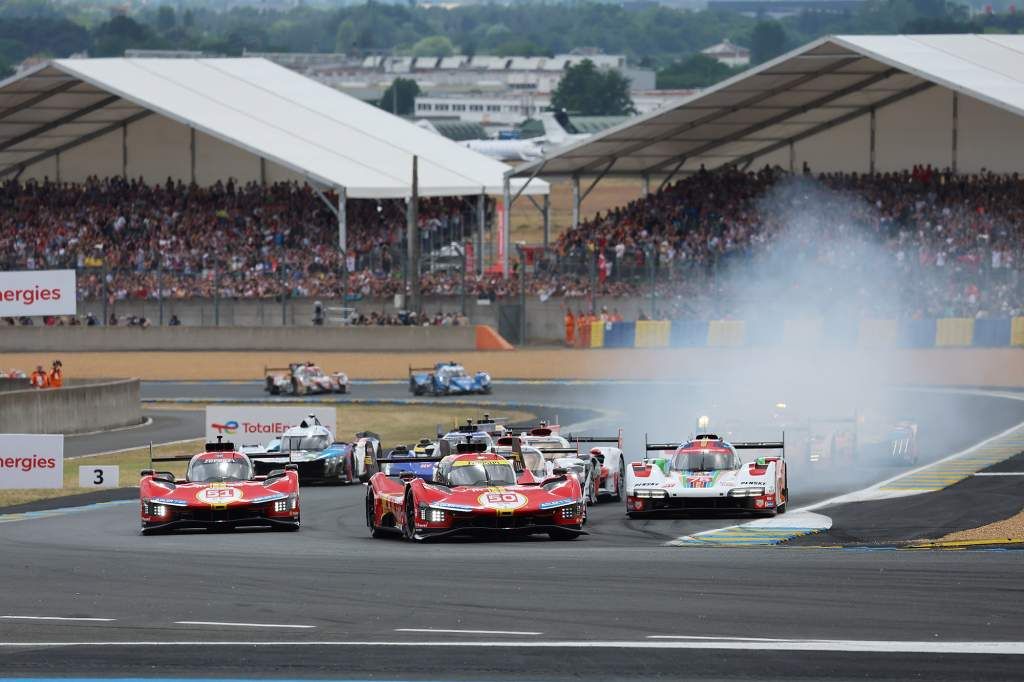Back at its best or contrived? Our Le Mans 24 Hours verdict
So, Ferrari has won the 2023 Le Mans 24 Hours. Victory on its top-flight sportscar racing return at the circuit, and in the centenary edition of the race, seems a fitting result.
All the better for the narrative too that there was a genuine scrap with previous dominator Toyota for honours – though it was one no doubt influenced by pre-event World Endurance Championship balance of performance changes in the Hypercar class.
With that in mind, was this Le Mans back at its peak? How should the result be seen in context of the BoP changes? Did the broadcast do enough to capture the best of the race and all of its intricacies? And how well were the post-safety-car restarts handled?
Our writers have their say on those topics and more:
BRILLIANT BUT B O P LEAVES ME UNEASY
Edd Straw
The Le Mans 24 Hours was a gripping race, one that was only settled decisively in Ferrari’s favour with an hour-and-three-quarters remaining.
It seems churlish to raise any objections, but the hypercar class’s balance of performance leaves me uneasy.
In late May, Toyota was slapped with an extra 37kg. Ferrari’s weight also went up by 24kg, meaning a 13kg gain relative to its main rival. That’s worth significant performance and, without it, the balance of power between the two would have been fundamentally different.
It’s important to note that this is baked into the hypercar class regulations. One of the reasons manufacturers have flooded back to top-class sportscar racing, with more to come, is this set of regulations. They are conceived to balance up the performance potential of the cars technically – and that encompasses not only the pure hypercars that compete in the class but also the LMDh machines, with the BoP mechanism existing to fine-tune the relative pace.
Your guide to every manufacturer in WEC’s new era Read more
But there are two reasons for disquiet. The first concern is the fact the WEC sporting regulations effectively outlaw public comment on BoP through a rule stating that “manufacturers, competitors, drivers and any persons or entities associated with their entries must not seek to influence the establishment of the BoP or comment on the results, in particular through public statements, the media and social networks”. It seems competitors were reminded of this regulation strongly before Le Mans. But that can be shrugged off as the rules everyone signed up for.
The second worry is one that can be allayed by how the coming years play out in that there’s a risk it could become a competition in which manufacturers take turns. This year, Ferrari and Toyota had the pace to win on merit – and ideally there would be more – but there’s a risk that BoP, no matter how scrupulously measured, passes around the advantages from one year to the next. And even if it succeeds, there’s an unease I can’t shake with the fact that it ceases to become a competition in which car design is key, relinquishing that element in the pursuit of a guaranteed close battle.
That’s what the now-defunct GTE Pro class became. It produced some great battles year after year, but the fact that it happened in most Le Mans 24 Hours somehow made it run of the mill with little sense around which manufacturers were in and out of contention in any given year as it fluctuated.
This year’s 100th anniversary race was one I couldn’t take my eyes off, although that is always the case for Le Mans. But in the back of my mind is the fear that this could just settle into becoming contrived and less special for that.
I hope I’m wrong and this really is the start of a golden era for Le Mans as the influx of manufacturers and wider public interest is very welcome. But this kind of performance balancing, which it should be noted also existed in some form before the hypercar era, is fraught with danger. It needs to be handled right.
An instant upgrade with one big sting
Alice Holloway
Looking at the competitiveness of all cars in the Hypercar field – something that hasn’t been seen in any of the WEC races so far – the Le Mans 24 Hours can only be a fantastic sign of what is to come for future editions of the race.
An unpredictable result with the winners and favourites changing every hour; it’s everything the WEC and Le Mans have been missing for, at least, the last seven years and makes the last few Le Mans even more forgettable.
The racing standards of the field were mixed, but a lot of this was due to wrong tyres at the wrong time. The rainfall was unpredictable and sudden, not falling evenly over the track, which made the surface bone dry one moment and soaking wet the next.
Ferrari wins Le Mans 24 Hours on its top-class comeback Read more
Was it best to pit for wets just to not pirouette off or was it worth risking the dry tyres as the rest of the track didn’t require the extra grip? It’s a difficult one to find a solution to because it requires having control of something that cannot be controlled: the weather and to an extent the quality of the amateur drivers which are so integral to the spirit and business of endurance racing.
The stinging in this race though was the new safety car procedure. While the theory of why the changes were made remains understandable, the execution of the new process was confusing for fans and very long-winded. Imagine being a new fan tuning in and watching the field doing 60km/h for over an hour at a time. Not great TV!
Perhaps ahead of next year, more testing and trials of different systems could be done ahead of the race to make sure the explanation to the fans is clearer and it takes as little time as possible to restart racing once the track conditions are safe.
B o P brought out the best in Toyota
Jack Cozens
Even before the much-discussed balance of performance changes were made, Ferrari and Toyota were always likely to be the two best manufacturers at the Le Mans 24 Hours.
I share the same reservations about the pre-event balance of performance adjustments as so well laid out by Edd and Toyota is right to feel hard-done by, but beyond the fact there was, fundamentally, a closer and more entertaining race as a result, we got to see a Toyota squad that has been the WEC’s benchmark for so long performing at its absolute peak.
In the face of a BoP system that levels the field and in this case brought Toyota down a notch, so in turn that meant the team had to elevate its own output.
However minor, Ferrari definitely seemed to have the edge on pace yet inside the final two hours of the race the #8 Toyota was just 15 seconds shy of the lead. The #7 too was among Ferrari’s leading challengers until its race-ending involvement in a bizarre crash.
The sporting argument remains a delicate one, but Toyota’s resolve was the lasting impression for me – that, and how welcome it was to see the other three factories (Cadillac, Peugeot and Porsche in the hands of customer Jota) being capable of cameos at the front of the order.
SAFETY CAR ISSUES NEED RESOLVING
Josh Suttill
Cries to rename the race the ’24 hours of safety cars’ were heard before sunset on Saturday.
This wasn’t helped by the first interruption coming on the opening lap for Jack Aitken’s sizeable shunt.
It wasn’t so much the interruptions themselves that were the problem – accidents are always going to happen in such a demanding race and safety is paramount – but the length and way the interruptions were handled seemed ill-executed.
The controversial three safety car rule seemed to only confuse and unnecessarily elongate safety car periods, even if they probably did a decent job of keeping the order bunched up.
It seemed puzzling at times why the safety car needed to stay out for so long – not helped by the broadcast often not showing the progress of the barrier repairs or car/s removal – and why it couldn’t transition into a green flag/slow zone mash-up.
Once the track was clear it also took far too long to get things back underway.
I fear not everyone – especially those Formula 1 and IndyCar fans tuning in for the first time – would have had the patience to stick around until the race resumed.
For those who did stick around we were treated to a magnificently enthralling race – but it should be clear that safety car periods should be near the top of the agenda to fix for the future.
CASUAL VIEWERS NEED A BIT MORE HELP
Valentin Khorounzhiy
Even keeping both the concerns over the artificiality of balance of performance and the various in-race organisational matters that clearly need sorting out in mind, this was clearly a far, far superior product to that of the Toyota walkover years, especially for the casual viewer.
Though the weather chaos helped shuffle the deck, nearly all the big-name new hypercar/LMDh manufacurers that were the big draw of this year’s event got their time in the limelight. One of them won the race, and did so in a proper lasting victory battle with memorable twists and turns. It might rankle purists – and they’re not necessarily wrong – but for a casual observer this surely goes down as a huge hit.
Should WEC get ‘creative’ like F1 or stay true to its format? Read more
But it’d be good to service those casual observers a bit more still, and the next frontier is approachability. There’s a certain segment of the audience that, I suspect, the Le Mans 24 Hours can and really should want to serve a bit better.
Those who are hardcore into endurance racing will soak up every minute and follow every car. Those who are visual or on-background casual followers might just want to vibe with the atmosphere and take in the one-of-a-kind night-time footage – nothing wrong with that.
But it’s obvious there’s a lot of those in the middle who don’t have the time or the stamina or, usually, both to follow in-depth, but are interested enough in the outcome to tune in periodically.
Flick it on after some time tending to some other business and, yeah, you tend to immediately know who’s leading and by how much. But what about the following question – how much time since the last pitstop? How much time until the next pitstop? Who’s been in the wars and when; how much did they lose and why? Which drivers have been excelling? There’s three per each car so it’d be nice to know. For bronze and silver drivers, how much time did they already spend on track of the required minimum amount?
And, extrapolating from all of that, who is best-positioned at any given moment to actually win this thing?
The commentators regularly dish on each of those topics, but you do not want them spending 24 hours recapping basic information over and over again – that would get intolerable for the committed audience. But the graphical package, while very tidy (and commendable for the stint estimates it does provide), can and should be less minimalistic and more robust.
It feels like F1 beams a lot more data into viewers’ eyes – and F1 is just much easier to follow. Le Mans – and the WEC as a whole – needs to figure out a good way to deliver the basics of the information available to the experts in a consistent visual way, to make a plug-and-watch approach a lot more rewarding.
Source: The Race


